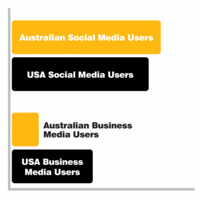Social Media: Should you or shouldn't you for your business?After speaking at a recent Women’s Network Australia event in Brisbane, and watching everyone take lots of notes, I decided to put some of my talk down into a paper. There is a lot to cover in this sphere, so here are some points to help people utilise social media more effectively.March 2011
No doubt, you’ve heard the buzz around social media and its role in business. The supporters believe that social media is the next big thing for SMEs, and that everyone should get on board. Its skeptics claim that social media is all fluff and no substance, a waste of time for business owners with better things to do. Like many of us, you’re probably wondering who’s right, and whether you should be using social media to broaden your business horizons or concentrate on more conventional marketing methods.
In Australia there is, on average, 16 million active Internet users per month. Of these, 83% have used social networks. 72% of social networkers use Facebook. On average, these users spend 25.8 hours using the Internet every month. Compare this with non-Facebook users who spend an average of 9.91 hours online each month, and you can begin to see the impact social media has on the average population’s Internet use.
Why are you taking on social media? What do you want to achieve? Do you want more people clicking through to your website? Do you want to add value for your current clients? Do you want to encourage sales? Do you want to increase your referrals? Is this a way to improve customer service by answering common questions? Do you need it for recruitment? Work out why you think you need a social media account. Perhaps you’ll find that you don’t need one, and that’s OK too.
Who are you targeting with your social media marketing? Are they prospects or existing clients?
How often do you plan to update your social media accounts? If you’re time poor, you will need to think about updating only once a week, but ensure you still check your accounts and keywords on a daily basis so you don’t miss any important information or opportunity. We’ll discuss this in further details in Part 2 of our article.
Stick to this routine by putting it in your default diary, and completing it at the same time everyday. It’s the best way to get results.
Research each social media site, and find out their strengths and weaknesses. Search for your target markets, interests, industries, and topics aligned to your business and see what results come up. Ask your clients what social media sites they use and their opinions of it.
How are you going to achieve what you want? One of the best ways to get ideas is to read stories about what others have done to get results. (See part 2 for some examples.) Then think about the past four questions and piece it all together. You may find you can have a few strategies and mediums to achieve what you want, or you may just have one.
When you know how you’re going to achieve your social media goals, write the plan down then review it on a scheduled basis. This area is still evolving, so you need to keep your plan up to date with the latest directions. If you are a Twitter user, follow www.twitter.com/mashable. They are one of the best to follow to keep yourself up to date with out having to read too much else. |



